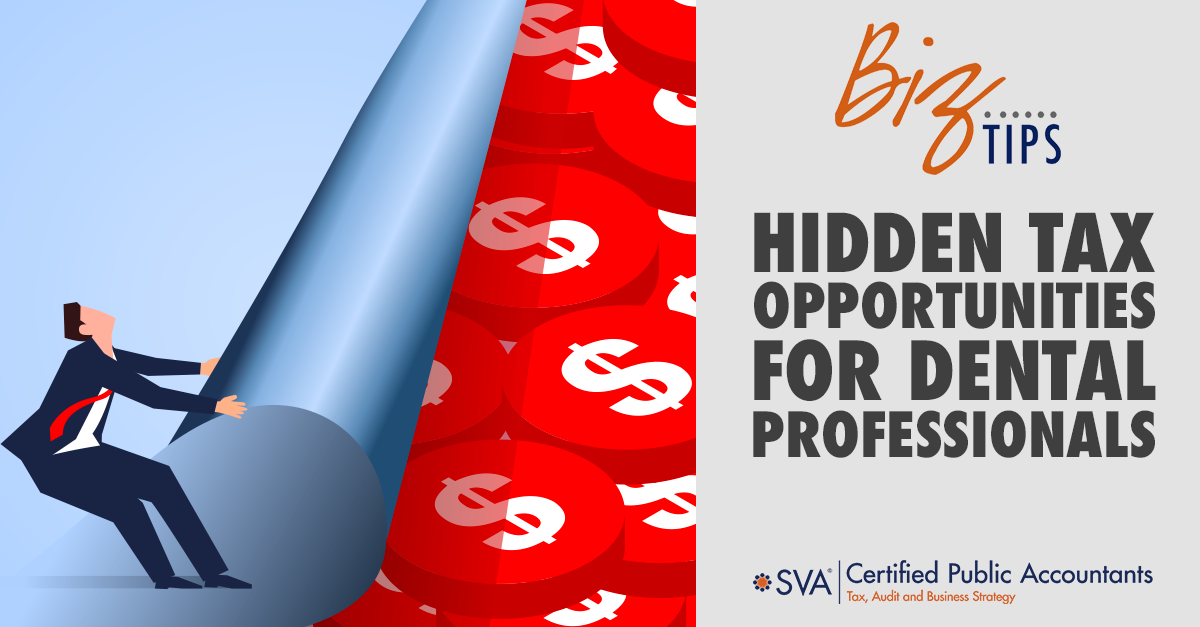

Published on: May 18, 2022 by Andy Slinger, CPA
Updated on: October 10, 2025
As a successful dentist, you will certainly pay your share of taxes but without a good understanding of tax-benefit strategies, you may be paying too much! Navigating the nuances of tax reform can be time-consuming.
To help you maximize the tax-saving opportunities available to you, here are 10 tax tips for dental practices.
Reviewing your entity selection is important because the type of entity you selected when you started your practice may be very different than what it should be now. It might change as you grow. It’s crucial, especially if you are thinking about selling your practice, that you are in the best position from the entity standpoint.
Typically, if you are just starting out, you're a small practice, or your revenue projection is low, you should form an LLC and be taxed as a sole proprietorship. If you purchase an existing mature practice, you should create an LLC and be taxed as an S corporation.
Your entity selection depends on your income and whether you own or rent the real estate you practice in (if you own, the property should be a separate entity). As a result, your entity can affect the benefits you offer in the practice and, with the Qualified Business Income Deduction, being a pass-through entity can save you significant taxes.
| With the passing of the One Big, Beautiful Bill (OBBB) in July 2025, there are changes to Qualified Business Income. Read the following Biz Tip to learn the latest updates on QBI: How QBI Deduction Permanency Affects Your Tax Strategy |
Also known as the Section 199A deduction, QBI is a tax deduction that allows eligible self-employed and small business owners to deduct up to 20% of their qualified business income. Qualified flow-through income can come from entities such as an S corporation, partnership, or sole proprietorship, as well as rental property.
There are some limitations to QBI:
Does your practice have a retirement plan? Are you using it? One of the top ways to pay less in taxes is to maximize your retirement fund contribution.
Examples of retirement plans include a SIMPLE plan, 401(k) plan with safe harbor or match, a plan with a discretionary component, and a cash balance plan. The most important question to ask yourself is, whichever retirement plan you currently have, is it the right plan for you right now?
The advantages of contributing to a retirement plan include:
There are tax-free benefits you can offer your staff which can assist your practice in recruiting and retaining top talent. As a bonus, it's an expense your practice can deduct and your staff (including you as the owner) does not pay tax on it.
Examples of tax-free fringe benefits include:
Have you made sure all your professional business expenses are paid or reimbursed to you through your practice? All ordinary and necessary expenses related to your business should be paid by the practice. Typical business expenses include continuing education, dues, journals, licenses, phone, computer, internet, etc.
The IRS says that all of your professional business expenses should be reimbursed within 60 days of incurring the expense. Best practice is for anything that should be paid by the business, use a separate business credit card. Then at the end of the month when you get the bill, turn it into your office manager so it is paid timely within the 60-day window. Also be sure to keep business and personal separate.
Another best practice is to make sure you keep all your receipts. No one ever wants or expects to get audited so be prepared in case it happens to you.
| With the passing of the One Big, Beautiful Bill (OBBB) in July 2025, there are changes to bonus depreciation. Read the following Biz Tip to learn the latest updates on bonus depreciation: Bonus Depreciation is Back: What Business Owners Need to Know |
Prior tax law contained a bonus depreciation where you could take a deduction immediately for 50% of the purchase of new property. Now bonus depreciation is 100% on new or used property with an IRS tax life of less than twenty years.
Examples of new or used property include any equipment or furniture used in your practice. It also includes land improvements and some qualified improvement property (i.e., buildouts where you are not expanding the actual footprint of your practice but anything you're building on the inside of the practice).
| With the passing of the One Big, Beautiful Bill (OBBB) in July 2025, there are changes to the Section 179 deduction. Read the following Biz Tip to learn the latest updates on the Section 179 deduction: Section 179 Gets a Boost With New Expensing Limits |
Section 179 is an additional type of depreciation that can be taken along with bonus depreciation. The maximum deduction is $1 million with the phase-out limit at $2.5 million. There's also a special $25,000 SUV rule that applies to equipment with a gross vehicle weight of over six thousand pounds, so any full-size SUV or truck.
Comparing section 179 and bonus depreciation, why would you take one versus the other?
New tax laws have completely changed how we make charitable contributions if the goal is to get a tax deduction. Consider the effect of the new increased standard deduction which essentially is double what it used to be. If your charitable contributions fall below the standard deduction in any given year, you receive no tax deduction on those contributions.
To donate to charity and receive a tax benefit, forecast the next three to five years of your charitable contributions. With a donor-advised fund, you receive a tax deduction in the year you fund it. For example, if you wanted to contribute $100,000 to charity in the next four years, you can take the deduction in year one of funding the donor-advised fund. That fund then essentially becomes a checking account for making future donations over the next four years, which you would then take the standard deduction in those subsequent years.
The most powerful way to fund charity from a tax perspective is if you are 70 and a half and need to take required minimum distributions (RMDs). You can take up to $100,000 of your RMDs and fund it directly to charity without being taxed on it. It further lowers your adjusted gross income for tax purposes as well as reduces your IRMAA (income-related monthly adjustment amount) for Medicare.
If you are going to employ a family member, they must perform ordinary and necessary work for the business. By employing a family member in your practice, you can receive the standard deduction if it’s through the payroll for your company and it’s a valid deduction. In turn, the family member would pay no income tax on that income based on the standard deduction covering it. So the cost to the business would be the payroll taxes on those wages.
One of the most popular tax considerations is deferring revenue into the following year and accelerating expenses into the current year. In this electronic world where little cash/checks exchange hands, deferring revenue is hard to control. But what you can control could potentially be deferred into the next year.
In regards to expenses, look into January to see what expenses you can pay in December. Most dental practices use a cash-basis accounting method, so it's when you receive the money and when you pay the bills that the revenue and expenses are recognized. If cash flow is not a problem, pay as many expenses as you can in December to reduce your taxable income.
Some states have implemented an election in which taxes can be paid at the entity level for flow-through entities (i.e., S corporations and partnerships), as opposed to individually. Even though the state tax at the entity level may be a bit higher than at the individual level, the tax is deductible on the federal tax return. If you are one of the higher tax rate payers, this can be a way to plan and minimize some of your taxes.
SVA Certified Public Accountants’ team members have in-depth knowledge of the dental industry that only comes with years of experience working with practices like yours.
We can help with every life stage of your practice – from start-up, through the growth phase, and eventually when you transition out of the practice. Contact us today. We are here to help.
© 2022 SVA Certified Public Accountants
Share this post:

Andy is a Principal with SVA Certified Public Accountants and focuses on the dental, veterinary and healthcare industries. He works with practices to manage their financial matters and set short and long-term goals.
Get Weekly Biz Tips Delivered Straight to Your Inbox!
Services
Madison, WI
1221 John Q Hammons Dr, Suite 100
Madison, WI 53717
(608) 831-8181
Milwaukee, WI
18650 W. Corporate Drive, Suite 200
Brookfield, WI 53045
(262) 641-6888
Colorado Springs, CO
10855 Hidden Pool Heights, Suite 340
Colorado Springs, CO 80908
(719) 413-5551

Are you in the know on the latest business trends, tips, strategies, and tax implications? SVA’s Biz Tips are quick reads on timely information sent to you as soon as they are published.
Copyright © 2026 SVA Certified Public Accountants | Privacy Policy | Cookie Policy | CCPA